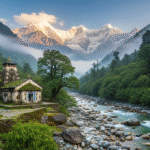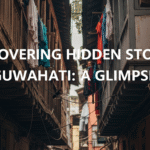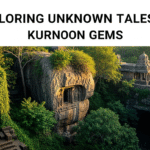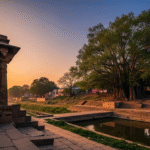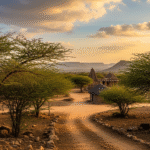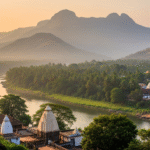Close your eyes and think of a place where nature whispers around you. Shivamogga is exactly that. In Karnataka’s heart, it’s a quiet break from busy city life. With old tales, green lands, and stunning waterfalls, it shows the treasures left to find. From Jog Falls’ grand fall to the green-filled Kodachadri Hills, Shivamogga charms every visitor.
Key Takeaways
- Jog Falls, India’s second highest waterfall, plunges from a height of 253 feet.
- Kodachadri, a natural heritage site, holds the title of the 10th highest peak in Karnataka.
- Honnemaradu offers adventurous activities like hiking, kayaking, and boating.
- Sakrebailu Elephant Camp allows visitors to witness elephants in the river backwaters.
- Gudavi Bird Sanctuary hosts 191 varieties of birds, presenting a paradise for bird watchers.
- Ikkeri houses the ancient Aghoreshwara Temple, showcasing intricate carvings dedicated to Lord Shiva.
- The best time to visit Shivamogga is from October to March when the weather is most pleasant.
Exploring Jog Falls: The Cascading Wonder
Jog Falls is in Shivamogga, one of India’s highest waterfalls. It stands tall at 253 meters. It’s a key spot in the Shivamogga travel guide. The falls have four cascades named Raja, Roarer, Rocket, and Rani. Viewing them from the base, after going down 1,400 steps, is amazing.
Overview of Jog Falls
Jog Falls is among Asia’s tallest waterfalls. It draws visitors from everywhere. The falls are stunning in the monsoon, thanks to the Sharavathi River. The area around is green and peaceful, adding to its charm.
Best Time to Visit Jog Falls
The best time to see Jog Falls is from June to September. The waterfall looks amazing then. For travelers, Hubli Airport and Sagar Jambagaru railway station make the trip easy.
Activities Around Jog Falls
Around Jog Falls, you can find many fun things to do. You can go trekking or on guided treks. Picnic spots offer great views.
- Trekking: Trails here give exciting trekking adventures.
- Guided Treks: Sharavathi Wildlife Sanctuary offers treks to see wildlife and plants.
- Picnicking: There are beautiful spots for picnics.
Dabbe Falls, Linganmakki Dam, and other places are nearby. The Tyavarekoppa Lion and Tiger Safari and Bynekaadu Homestay are unique spots here. Shivamogga offers cool wildlife and places to stay.
When visiting, try local food and explore historic sites. This makes your trip even better.
Discovering the Biodiversity at Kodachadri Hills
Kodachadri Hills stand tall in the Shimoga district of Karnataka. They peak at 1,343 meters above sea level. This spot is a favorite among tourists for its amazing views and greenery.
Introduction to Kodachadri Hills
Kodachadri Hills are a key spot for biodiversity. It’s not just famous for trekking but also for its ancient Mookambika Devi Temple. Attractions like Jog Falls and Agumbe Rainforest Research Station are nearby. This makes it a top place to visit in Shivamogga.
Trekking Experiences
The trek at Kodachadri is 14 km long. It gives trekkers a thrilling experience. You can choose the challenging 12km path through dense forests or the shorter 6km Gundya Mane Trek.
On the way, you see the Hidlumane Falls and the Sarvagna Peetha temple. Going up takes about four hours and coming down three to four hours. There are lots of streams and the beautiful Hidlumane waterfall.
Flora and Fauna
Over 500 bird species live in the Kodachadri Hills. This includes the Malabar Whistling Thrush and the Great Hornbill. You’ll also find animals like the Malabar Langur and the Pied Hornbill here. The area is rich in plants unique to this place. It’s a must-visit for nature lovers and those into wildlife.
Experience Wildlife at Mandagadde Bird Sanctuary
Mandagadde Bird Sanctuary is a quiet spot for bird lovers. It’s on an island on the Tunga river in Shivamogga. It’s best for bird watching, especially in the rainy season. This season draws many birds, making it a great time to visit.
Bird Watching
This sanctuary is full of life, especially when birds migrate here. From June to December, over 5,000 birds visit. You’ll see Median Egret, Darter, and Little Cormorant among others.
There are viewing platforms for a closer look. They help you see the birds well. This makes it a special place in Shivamogga for enjoying nature.
Best Season to Visit
Visit during the rainy and just after rainy seasons, from July to September. This time is great for seeing migratory birds. The sanctuary covers 1.14 hectares and is alive with birds then.
If you go during these months, you’ll enjoy seeing the sanctuary full of life. It’s a top spot in Shivamogga for nature. You’ll love the birds’ songs and the beauty around.
You can also explore other places nearby. Like the Gudavi Bird Sanctuary with many seasonal birds. Or the Tyavarekoppa Lion and Tiger Reserve, 10 km from Shimoga. It offers exciting safaris. These places make the area perfect for lovers of nature and adventure.
Tourist Places in Shivamogga: A Comprehensive Guide
Shivamogga is in Karnataka. It is full of nature and culture. This guide talks about the best places to see.

Start at Sakrebailu Elephant Camp. It has more than 50 elephants. Visitors can interact with these elephants. Visit the old town of Keladi too. See the Rameshwara Temple’s beautiful architecture.
If you like calm places, go to Honnemaradu. It is near the Sharavathi River. You can do water sports and camp here. Agumbe is known as the “Cherrapunji of South India.” It has green rainforests and great sunsets.
For adventure, see Dabbe Falls. It is very high. Or climb Kundadri Hills. It has an old Jain temple. Kodachadri Hills has lots of plants and animals. It’s good for trekking.
If you like birds, go to Mandagadde Bird Sanctuary. It welcomes birds from July to October. Also visit Gudavi Bird Sanctuary. It has over 48 bird species. Bhadra Wildlife Sanctuary is where you can see tigers, elephants, and panthers.
You can also see lions and tigers at Tyavarekoppa Lion and Tiger Safari. Sharavathi Wildlife Sanctuary protects rare animals. It offers safaris and walks.
Heggodu is for cultural experiences. It has NINASAM, a famous arts group. Gajanur Dam is nice for picnics and watching birds. It helps with farming too.
In short, Shivamogga has many places for all kinds of travelers. This Shivamogga travel guide will help you explore its beautiful nature and culture.
| Destination | Highlights |
|---|---|
| Sakrebailu Elephant Camp | Interact with over 50 elephants |
| Keladi | Historic Rameshwara Temple |
| Honnemaradu | Water sports and camping |
| Agumbe | Rainforests and stunning sunsets |
| Dabbe Falls | Falls from 110 meters |
| Kundadri Hills | Ancient Jain temple at 3200 feet |
| Kodachadri Hills | Diverse trekking routes |
| Mandagadde Bird Sanctuary | Migratory birds (July to October) |
| Gudavi Bird Sanctuary | Hosts over 48 bird species |
| Bhadra Wildlife Sanctuary | Sightings of tigers, elephants, and panthers |
| Tyavarekoppa Lion and Tiger Safari | Guided safari tours |
| Sharavathi Wildlife Sanctuary | Protects endangered Lion-tailed Macaque |
| Heggodu | Home to NINASAM cultural organization |
| Gajanur Dam | Picnics and bird watching |
Cultural and Historical Insights at Keladi
Keladi is a place full of culture and history. It is located in Sagara Taluk, Karnataka. Here, you can learn about the Keladi Nayakas from the Vijayanagara Empire. Their stories and buildings are amazing. The Rameshwara Temple is a key spot to see the history of South India.
History of Keladi
Keladi has a rich history linked to the Nayakas’ rule. They were big leaders during the Vijayanagara Empire. The Rameshwara Temple shows off their era’s art. It mixes Hoysala and Dravidian styles. Keladi was once the Nayakas’ home, showing their strength and faith.
The Nayakas played a big role in keeping the area’s art and culture alive. Thanks to them, Shivamogga has many historical spots. The Keladi Museum is a special place. It has rare items and old writings that tell us a lot about Shivamogga’s culture.
Architectural Significance
The Rameshwara Temple in Keladi Shivamogga is very important for its design. Its outside is simple but grand, while the inside is full of detailed carvings. The designs on the pillars and ceilings show the beauty and spiritual beliefs of that time.
In the Rameshwara Temple, there are three main shrines for Parvati, Rameshwara, and Veerabhadra. There are also beautiful sculptures of Navagrahas, Nagamandala, and Gandaberunda. These make the temple a must-visit for history lovers. The statue of Daksha Prajapati with a goat head and the Vastu Purush are really interesting.
Below is a table that compares some famous temples and their details in this area.
| Temple | Era | Significance |
|---|---|---|
| Rameshwara Temple | 15th Century | Blend of Hoysala and Dravidian architecture |
| Kaitabheshvara Temple | 11th Century | Unique sculptural motifs influenced by Chalukyan architecture |
| Amruteshvara Temple | 12th Century | Intricate sculptures and unparalleled artistry |
| Padmavathi Temple | Medieval Period | Revered site among the Jain community |
These temples tell the stories of Shivamogga. They let visitors dive deep into the area’s amazing heritage.
Conclusion
The Shivamogga district in Karnataka is full of amazing experiences for travelers. It stands out in India. Places like Jog Falls and Kodachadri Hills tell unique stories.
You can see tigers, leopards, and elephants at Sharavathi Wildlife Sanctuary. Keladi village shows off old architecture like the Keladi Rameshwara Temple. Bird lovers will enjoy Mandagadde Bird Sanctuary. And don’t forget Sakrebayalu Elephant Camp for elephant fun.
Getting there is easy with Mangalore airport about 200 kilometers away. Soon, a new airport will open too. You can hike in Agumbe or learn at Tyavarekoppa Lion and Tiger Safari. Shivamogga has adventure and learning together.
Discover the wild beauty of Dabbe Falls and the history of Thirthahalli. Shivamogga shows India’s untouched charm. There are many places to stay, from fancy resorts to affordable hotels. This district invites everyone to explore its beauty and history.
For more about Shivamogga, check the Wikipedia page on Shimoga district. Learn what makes Shivamogga special. Every part of this region is waiting for travelers to discover its beauty and history. Your visit will be unforgettable.
FAQ
What are the top tourist places in Shivamogga?
Some of the top tourist places in Shivamogga include Jog Falls and Kodachadri Hills. Also, Mandagadde Bird Sanctuary and Sakrebailu Elephant Camp are popular. Places like Keladi with its Rameshwara Temple, Honnemaradu, and Agumbe are must-visits too. Don’t forget Dabbe Falls and Kundadri Hills.
What makes Jog Falls a must-visit location in Shivamogga?
Jog Falls is India’s second-highest waterfall with a 253 ft drop. It has four different falls: Raja, Roarer, Rocket, and Rani. These falls are in a dense, green area. They are most impressive post-monsoon with lots of water.
When is the best time to explore Mandagadde Bird Sanctuary for bird watching?
The best bird watching at Mandagadde Bird Sanctuary is from June to December. This is when many birds come here to breed. It’s during and after the monsoon.
What can visitors expect at Kodachadri Hills?
Visitors to Kodachadri Hills will find beautiful trek paths through forests. There are also stunning views and wildlife like the Malabar Langur. Kodachadri is a great spot for those who love nature and adventure.
What are the highlights of the historical town of Keladi?
Keladi is famous for its history. The Rameshwara Temple there mixes Hoysala and Dravida styles. It tells the story of the Keladi Nayakas’ impact on culture and religion.
Are there any other lesser-known but significant tourist spots in Shivamogga?
Yes, Shivamogga has hidden gems like Heggodu, home to the NINASAM cultural group. There are also Mattur and Hosahalli villages. They’re known for their interesting cultural practices.
What activities can tourists enjoy at Shivamogga’s popular spots?
Tourists can try many things in Shivamogga, like trekking in Kodachadri Hills. Bird watching at Mandagadde Bird Sanctuary is great too. Also, exploring historical sites in Keladi is interesting. People love visiting the elephant camp at Sakrebailu. And don’t forget about picnicking at Jog Falls!
What is the best time of the year to visit Shivamogga?
Shivamogga is good to visit any time, but the waterfalls, like Jog Falls, are best seen post-monsoon. This is when they’re full of water. For bird watching, come during or right after the monsoon.


